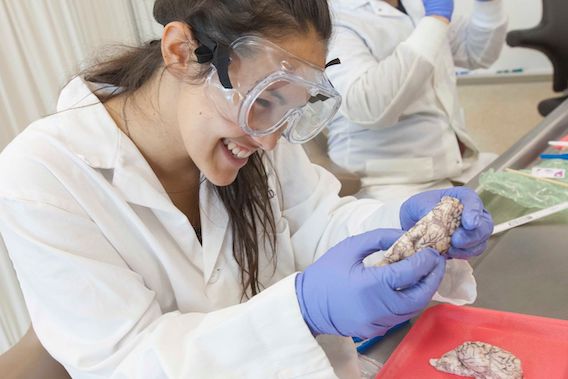
Throughout the COVID-19 pandemic, the essential role of health science workers has been front and center. Many health care workers are getting the respect and admiration they’ve long been due. A life committed to helping others is a calling many young Alaskans may want to answer, but what is the best way to do that as we return to our new normal? Prospects for some careers have dimmed, and entire industries have struggled to survive the pandemic. However, some science, technology, engineering and math fields are actually positioned to emerge stronger and with more opportunities than ever.
As companies transition to remote work environments, people are relying more heavily on digital communications. High-speed internet and software like Zoom have enabled ANSEP students to continue summer components like Acceleration Ready, Acceleration Academy (Summer) and Summer Bridge from the safety of their own homes.
STEM skills have proven to be invaluable in the recent months, and these are the STEM careers that will likely drive our post-pandemic future:
- Software developer: According to a Monster study, the majority of employers would consider changing their work from home policy if employees could maintain productivity. Many companies, including Twitter, have decided to work remotely permanently. Strong software architecture to support remote employees is critical and Grow anticipates a 28% growth in this industry.
- App designer: In an effort to reduce face-to-face interactions and practice social distancing, more consumers turned to delivery apps for groceries, meals, household items and even lattes. According to Apptopia, Instacart downloads increased by 218% in March. Blue Apron stock is soaring and meal delivery services from GrubHub, Uber Eats and others have increased by 70%. As people turn to mobile delivery services, the demand for computer coders, software engineers and systems analysts who write code for the programs will also increase.
- Robotics engineer: Not only are robots often a cheaper solution long-term, automation allows factories and manufacturing plants to continue operations without risking human interaction in the midst of a pandemic. Using robots for cleaning hospitals, accepting digital payments and running factories further protects essential employees. As we trend towards automation, the need for robotics engineers is increasing. The World Economic Forum predicts an increase of 6.1 million automation jobs globally in the next two years.
- Data scientist: Fast Company called this STEM career one of the fastest-growing jobs in America. Being a data scientist involves using technical skills to create algorithms, analyze large amounts of information, predict trends and create actionable insights. Previously the tech industry accounted for almost all of these jobs. Now, according to LinkedIn co-founder Allen Blue, there has been a 20% increase in data scientist jobs in education, manufacturing, marketing and other industries.
- Biomedical engineer: These STEM specialists use their combined knowledge of engineering and medicine to create lifesaving medical systems, supplies and equipment. From designing surgical robots to mass-manufacturing N95 masks, they are critical during a pandemic. Biomedical engineers will remain important as people place an increased emphasis on quality health care and public health.
- Virologist: This health science field studies viruses and virus-like agents. Virologists typically work in a research or teaching capacity to understand how viruses spread, how to isolate them and treat them. Most virology careers require a bachelor’s degree in biology as well as a specialized microbiology master’s and doctoral degree.
- Public health professional: The Center for Disease Control defines public health as the science of protecting and improving the health of people and their communities. Public health professionals usually must have a STEM degree and often work for government agencies, nonprofits, health care organizations and educational institutions. They are responsible for making informed decisions like how long communities remain on lockdown and other measures to stop the spread of diseases.
- Artificial intelligence and machine learning specialist: This relatively new profession applies machine learning and artificial intelligence to real life by writing and analyzing algorithms. STEM professionals convert data into trends that can be applied to a variety of industries, including manufacturing, banking, technology and, most recently, health care. These skills have been used to study the coronavirus, test potential treatments and track diagnostics.
- Digital transformation specialist: Study.com defines this as using design skills and technology to produce content used in video games and websites, as well as audio content, special effects, and animation. This already growing specialty’s need was amplified by COVID-19 as people spent more time at home and sought additional ways to entertain themselves with technology.
- Information technology manager: This career choice requires a bachelor’s degree, and sometimes a master’s degree as well, in computer sciences. They oversee troubleshooting and technological innovation within companies. This became increasingly important as companies transitioned to remote working and needed stronger firewalls with better security and infrastructure to support collaboration. The health care industry also used this to share information and resources, track outbreaks and communicate with the public.
- Biological technician: A job as a biological technician involves assisting scientists in laboratories by helping set up, operate and maintain laboratory instruments and equipment. Biopharmaceutical companies are leading the fight against COVID-19 by studying diagnostics, vaccines and therapeutics. UAA offers a bachelor’s degree program in natural sciences that will put students on the path to a biological technician career.
- Environmental science and protection technician: Environmental science and protection technicians help perform laboratory and field tests to monitor the environment and investigate sources of pollution. The planet is reaping the benefits from social distancing, according to environmental scientists who are studying the impact of reduced pollution, re-emerging wildlife and more.
Students who want to pursue a job in this field can take classes at UAA, which offers a bachelor’s degree in natural sciences.
- Occupational health and safety specialist: Another career path offered at UAA is a bachelor’s degree for a job as an occupational health and safety specialist. This specialist ensures that a working environment is safe for both patients and employees. As companies tackle difficult questions about when and how to return to work post-COVID, this will be an increasingly important career.
- Registered health information technician: A registered health information technician files and verifies the accuracy of electronic health records. There is a bachelor’s degree program in health science offered at UAA that can be used towards this career path. These technicians are instrumental for hospitals looking to use contact tracing and other information sharing to slow the spread of the coronavirus.
- Medical lab technician: Medical lab technicians typically work in hospitals, labs and physicians’ offices and perform tests on blood, tissues and other samples to help physicians diagnose and treat diseases. Our nation is currently experiencing a heightened interest in easy access to test results and contact-free testing. Many people will expect this expedited testing capacity to remain as society transitions to the new normal. Students interested in medical lab work can pursue a bachelor’s degree in medical laboratory science from UAA.
- Statistician: Several industries, including engineering, science, business and health care rely on statisticians to make predictions and solve problems. Recently, the Department of Statistics collaborated with Stanford Medicine to combat the coronavirus by tracking gene mutations, developing predictive modeling and designing clinical trials. This field requires a bachelor’s degree in statistics or mathematics and often a master’s in statistics as well.
- CRISPR scientist: CRISPR is a new type of technology used to alter DNA sequences and modify gene function to develop biological products for treating diseases. According to Chemical and Engineering News, a new nasal swab diagnostic test for COVID-19 is the first FDA-authorized use for CRISPR. Estimated to reach $5.3 billion in market value by 2025, CRISPR was discovered by female scientists. This emerging career path is quickly attracting more women in STEM. Students interested in this career path should study molecular biology or biological chemistry.
- Video game designer: Online streaming, including the use of video games and computer games, has significantly increased since the start of the pandemic. The Washington Post reports that video game sales are up 35%, Microsoft Game Pass engagement increased by 135% and people spent 1.49 billion gaming hours on Twitch in April alone. Video game designer salaries can top $100,000 and the career typically requires a bachelor’s degree in computer science or engineering.
- Remote STEM teacher: Distance learning and other remote education options are becoming increasingly popular as parents consider the safety of returning to the classroom. Educating the next generation of STEM professionals is more important than ever. College graduates from any field can apply to become teachers in Alaska, so long as they complete the teaching program certification.
- Epidemiologist: According to the CDC, “epidemiology is used to find the causes of health outcomes and diseases.” It assesses their frequency and pattern as well as the associated causes and risk factors. Epidemiologists then use this information to determine how diseases and other health events impact neighborhoods, schools, cities, states and other populations. This career path typically requires a bachelor’s degree in any science field combined with a master’s in epidemiology. The Bureau of Labor Statistics predicts a 24% growth in this field over the next decade.
These are only 20 jobs that are predicted to see an increased demand post-COVID, but there are many more career opportunities that are crucial for maintaining a healthy society. Want to find out more about how ANSEP is preparing Alaska’s next generation workforce? Visit the “Who Can Join?” page for more information.



